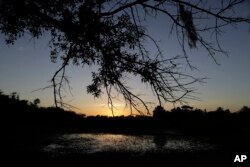The U.S. government carefully designed a path of least resistance to building a border wall in Texas, picking a wildlife refuge and other places it already owns or controls to quickly begin construction. All it needed was Congress to approve the money.
Then came Harvey.
President Donald Trump's administration must now grapple with a storm that devastated the Texas Gulf Coast, with some areas still underwater and tens of thousands of people forced from their homes. Rebuilding will require billions of dollars to start — and may come at the expense of what is perhaps Trump's best-known policy priority.
The White House wanted $1.6 billion for 74 miles (120 kilometers) of initial wall, including 60 miles (95 kilometers) in Texas' Rio Grande Valley.
While a fraction of what the overall recovery effort will cost, funding for the wall already faced strong opposition from Senate Democrats. Three days before Harvey made landfall, Trump threatened a government shutdown unless Congress provides funding. That threat now appears to be off the table, as is any potential maneuver to tie the wall to providing disaster relief.
"If Trump is saying, 'Listen, you're only going to get your disaster funding if I get my wall,' that is a total political loser," said Matt Mackowiak, a Texas-based Republican consultant. "That's just not tenable."
Before the storm hit, the U.S. government had spent months quietly preparing to begin new construction in Texas. The first construction site would be the Santa Ana National Wildlife Refuge, a verdant forest with butterflies and rare bird species next to the Rio Grande — that wasn't affected by Harvey.
Those preparations are still underway. At Santa Ana, crews were seen as recently as Friday drilling holes for testing the soil on the river levee built to withhold high waters from the Rio Grande. The head of the National Butterfly Center, also next to the border, recently caught workers chopping trees and mowing vegetation on her property without her permission. And contractors have been spotted at a courthouse in a neighboring county examining land ownership records.
The government wants to build on the 3 miles (5 kilometers) of river levee cutting through the northern edge of the refuge, separating the visitor center from the rest of the park. A gate in the wall would open and close for visitors. Vegetation in front of the wall would be cleared for an access road and open land to give agents better visibility.
Under current plans, another 25 miles (40 kilometers) would go on other parts of the levee, where government agencies are believed to control land rights and have previously built sections of fencing. The remaining construction would go through river towns further west, taking a route the government examined the last time it built a border barrier, under the 2006 Secure Fence Act.
Scott Nicol, co-chair of the Sierra Club's Borderlands campaign and a longtime opponent of the plan, said that the storm "should stop them from trying to build a wall."
"If we had an administration that was acting responsibly, that was acting in the best interest of the United States, they would say, 'We have a much more important thing to do right now,'" Nicol said.
Law enforcement officials in the Rio Grande Valley say the wall is part of their strategy to slow the entry of drugs and illegal immigration. And they want to avoid the issues that stymied the U.S. government after the Secure Fence Act. That resulted in hundreds of lawsuits and years of delays in Texas, and yielded just 100 miles (160 kilometers) of fencing in the state.
That's why they want to start in Santa Ana.
"That is government property already," Manuel Padilla, the Border Patrol's Rio Grande Valley sector chief, told The Associated Press last month. "So we don't have to deal with the landowner because that's a process and it takes time."
The Valley is the nation's busiest place for illegal border crossings. Agents routinely catch human and drug smugglers along the state's 800-mile (1,290-kilometer) border with Mexico, most of which is not fenced.
"Smugglers exploit the refuge because it has limited access to law enforcement," Padilla said.
Opponents say Padilla is overstating the threat in the refuge. The Border Patrol says its agents have intercepted just eight human smuggling cases in Santa Ana since October. By comparison, during that same period, agents intercepted more than 2,000 human smuggling cases in the Rio Grande Valley overall.
Environmentalists say cutting through Santa Ana's forests would irreparably damage the area and endanger animals in the event of floods. Several endangered wildcats and 400-plus species of birds live at the refuge.
Still, the Department of Homeland Security can waive environmental and other reviews to expedite construction, as it's already done in San Diego, where the remaining 14 miles (22 kilometers) of border wall is currently planned. Even if Congress doesn't approve funding, the department might still be able to build in the refuge by reallocating money already in its budget.
It's a plan that would be hard for opponents of a wall to stop. But after Harvey, the state faces a rebuilding effort that will draw not just on government money, but the efforts of construction companies and natural resources that might have otherwise gone to a wall.
So far, Texas Republicans won't rule out a wall but say it shouldn't jeopardize Harvey recovery funding.
Sen. John Cornyn has filed a $15 billion border security bill that would build some new portions of border wall, though he opposes fencing off the entire, nearly 2,000-mile (3,220-kilometer) U.S.-Mexico border. He said the message from the White House so far has been to offer immediate storm aid without political strings.
Asked if he was concerned the border wall fight could tie up federal disaster spending, Gov. Greg Abbott said simply, "No."












